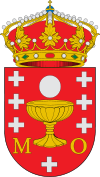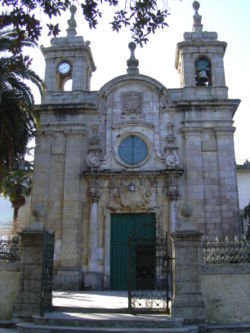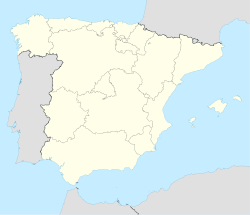- Mondoñedo
-
Mondoñedo — Municipality — Entrance to the Sanctuary of Remedios 
Coat of armsLocation in Spain Coordinates: 43°25′41″N 7°21′46″W / 43.42806°N 7.36278°WCoordinates: 43°25′41″N 7°21′46″W / 43.42806°N 7.36278°W Country Spain Autonomous community Galicia Province Lugo Comarca Mariña Central Government - Mayor Orlando González Cruz Area - Total 142.66 km2 (55.1 sq mi) Elevation 141 m (463 ft) Population (2009) - Total 4,508 - Density 31.6/km2 (81.8/sq mi) Demonym Mindonienses Time zone CET (UTC+1) - Summer (DST) CEST (UTC+2) Postal code 27740 Mondoñedo is a small town and municipality in the Galician province of Lugo, Spain. As of 2009[update], the town has a population of 4,508. Mondoñedo occupies a sheltered valley among the northern outliers of the Cantabrian Mountains.
Contents
History
After having been for nearly a century and a half in the hands of the Moors, Mondoñedo was recaptured by Ordoño I of Asturias in 858; and the Christian possession was made permanent by Alfonso III of León in 870. It was taken by surprise by the French in 1809 during the Napoleonic Wars.
The Galician Province of Mondoñedo disappeared in 1833 when all the seven provinces of Galicia were reduced to four, and the entire Province of Mondoñedo was first divided into two halves and later absorbed and assimilated into the existing provinces of Lugo and A Coruña.
Main sights
The town was declared a national cultural-historical site in 1985. Its main attraction is the Cathedral, begun in Romanesque style around 1230. It reflects an unusual mixture of styles: Gothic in the nave and the aisles, and Baroque in the its 18th century towers. The polychrome statue in the high altar, called Nuestra Señora la Inglesa (the English Madonna) was rescued from the St. Paul Cathedral in London during the Protestant Reformation of Henry VIII of England.
The Sanctuary of Remedios and the Hospital of San Pablo are both from the 16th century.
The Caves of King "Cintolo" ("Covas do Rei Cintolo") are also located in the outskirts of the town.
Sister cities
See also
- Mailoc or Maeloc
- Province of Mondoñedo
- Diocese of Ferrol-Mondoñedo
References
 This article incorporates text from a publication now in the public domain: Chisholm, Hugh, ed (1911). Encyclopædia Britannica (11th ed.). Cambridge University Press.
This article incorporates text from a publication now in the public domain: Chisholm, Hugh, ed (1911). Encyclopædia Britannica (11th ed.). Cambridge University Press.
External links
- History of Mondoñedo (Spanish)
- Mondoñedo's Website (Spanish)
Municipalities in the province of Lugo Abadín · Alfoz · Antas de Ulla · Baleira · Baralla · Barreiros · Becerreá · Begonte · Bóveda · Burela · Carballedo · Castro de Rei · Castroverde · Cervantes · Cervo · Chantada · O Corgo · Cospeito · Folgoso do Courel · A Fonsagrada · Foz · Friol · Guitiriz · Guntín · O Incio · Láncara · Lourenzá · Lugo · Meira · Mondoñedo · Monforte de Lemos · Monterroso · Muras · Navia de Suarna · Negueira de Muñiz · As Nogais · Ourol · Outeiro de Rei · Palas de Rei · Pantón · Paradela · O Páramo · A Pastoriza · Pedrafita do Cebreiro · A Pobra do Brollón · Pol · A Pontenova · Portomarín · Quiroga · Rábade · Ribadeo · Ribas de Sil · Ribeira de Piquín · Riotorto · Samos · Sarria · O Saviñao · Sober · Taboada · Trabada · Triacastela · O Valadouro · O Vicedo · Vilalba · Viveiro · Xermade · Xove
Ancient lands of the Counts of Andrade and Vilalba in the 14th century Abadín · Alfoz · Ares · Barreiros · Burela · Cabanas · A Capela · Cariño · Cedeira · Cerdido · Cervo · Cospeito · Fene · Ferrol · Foz · Guitiriz · Lourenzá · Mañón · Moeche · Mondoñedo · Monfero · Mugardos · Muras · Narón · Neda · Ourol · Ortigueira · A Pastoriza · Pontedeume · A Pontenova · As Pontes de García Rodríguez · Ribadeo · Riotorto · San Sadurniño · As Somozas · Trabada · O Valadouro · Valdoviño · O Vicedo · Vilalba · Vilarmaior · Viveiro · Xermade · XoveCategories:- Municipalities in Lugo
- Galicia geography stubs
Wikimedia Foundation. 2010.


